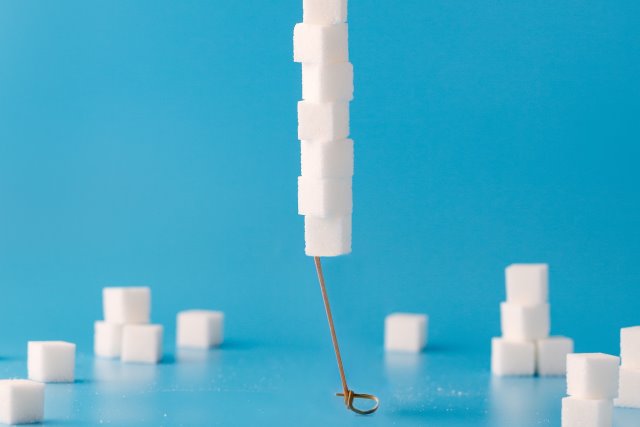Does your blood sugar rise every morning for no apparent reason?
You might be experiencing the “dawn phenomenon.” While frustrating, this occurrence is common, and this article will provide you with some strategies to prevent glucose spikes and help mitigate the dawn phenomenon.

The dawn phenomenon (and its consequences) affects people with type 1 diabetes, type 2 diabetes, and gestational diabetes. In fact, the hormonal changes that cause the dawn phenomenon happen to everyone, but for people with diabetes, the body does not automatically manage these daily metabolic changes. Successfully addressing the issue requires a mix of strategies, including natural methods (such as new diet and exercise habits) as well as changes in medication use, particularly insulin.
Why does blood sugar rise in the morning?
There are several possible causes of high morning blood sugar levels:
- Dawn phenomenon – This occurs because the body releases a surge of hormones overnight, which triggers the liver to release sugar into the blood. This is a completely natural process, but people with diabetes cannot properly secrete or use insulin to prevent a rise in blood sugar. The dawn phenomenon can start hours before you wake up.
- Reactive hyperglycemia – Also known as the Somogyi effect. This is different from the dawn phenomenon. It happens when low blood sugar levels in the middle of the night prompt the liver to release sugar into the blood in an attempt to stabilize.
- “Feet on the floor” phenomenon – Similar to the dawn phenomenon, this situation occurs when your blood sugar is in a good range when you wake up but immediately rises when you get out of bed and start moving around.
Finally, your blood sugar may simply rise overnight due to other, less complex reasons. Perhaps your basal insulin dose is not set correctly, or a late-night meal high in fat or protein took several hours to cause a glucose spike.
Let's start from the beginning – let’s find out why your blood sugar is high when you wake up.

Let's start from the beginning - let's find out why your blood sugar is high when you wake up.
The easiest way to understand your blood sugar levels during the night is by using a continuous glucose monitoring (CGM) system. A CGM will show blood sugar changes overnight, making it easier to track which direction your glucose levels are heading while you sleep.
If you don’t have a CGM (and if you have diabetes, you probably should), here’s a simple plan to diagnose the source of high morning blood sugar:
- Check your blood sugar before bed.
- Check your blood sugar in the middle of the night.
- Check your blood sugar first thing in the morning after waking up.
It takes some effort, but you only need to repeat this test a few times to diagnose the issue.
To identify either the dawn phenomenon or the Somogyi effect, experts such as the American Diabetes Association recommend checking blood sugar a few hours before you normally wake up, such as between 3 and 5 AM.
Compare these three glucose values and look for a pattern:
- If your blood sugar was stable before bed but rose early in the morning, you may have the dawn phenomenon.
- If your blood sugar remained stable overnight and did not rise until you got out of bed, you likely have the “feet on the floor” phenomenon.
- If your blood sugar steadily increased throughout the night, your high morning glucose levels may be due to dietary choices (e.g., a bedtime snack high in protein or carbohydrates) or a sign that you may need to adjust your insulin and glucose-lowering medication regimen.
- If your blood sugar dropped to low levels in the middle of the night and later spiked, the Somogyi effect is likely the cause.

How to fix high morning blood sugar
1. Dawn phenomenon
More than half of people with diabetes (including both types 1 and 2) experience the dawn phenomenon. This can lead to a significant increase in A1C levels.
The dawn phenomenon begins when your body releases a surge of hormones, including growth hormone, cortisol, adrenaline, and glucagon. These hormones start working very early every morning to prepare your body for waking up. Essentially, your body starts the engine, releases some fuel, and gets ready for the day.
These hormones trigger the conversion of liver glycogen stores into glucose, which is then released into the blood in a process called glycogenolysis.
This general process happens to everyone, regardless of whether they have diabetes. In people without diabetes, the body releases insulin in response, preventing a rise in blood sugar. However, in people with diabetes, the body is unable to produce a healthy insulin response, so blood glucose levels rise.
Mayo Clinic suggests several strategies to help counteract the effects of the dawn phenomenon:
- Use an insulin pump to deliver extra insulin during the early morning hours.
- If you take multiple daily injections, administer a bolus immediately in the morning.
- Avoid carbohydrates before bedtime.
- Switch to a different glucose-lowering medication.
- Adjust the timing of your glucose-lowering medication or insulin—some people find success by splitting their basal insulin dose into two or three daily injections, creating a more stable supply.
Some people with diabetes also notice that they have lower insulin sensitivity in the morning. You may need to limit carbohydrate intake for the first few hours after waking up. Insulin users may need a higher insulin-to-carbohydrate ratio and take more insulin in the morning than at other times of the day.
The dawn phenomenon is not universal, and in some cases, it’s not a major concern. If you spend most of the night with normal blood sugar and experience a small, temporary rise in the morning, changes may not be necessary. For those who are otherwise within their target blood sugar range, the morning increase is often smaller than the spike experienced during a typical meal and shorter-lived.
2. “Feet on the floor” phenomenon
The "feet on the floor" phenomenon is very similar to the dawn phenomenon, except that it occurs later. When you get out of bed, your body releases a surge of hormones to prepare for the day. This is natural, but for people with diabetes, it causes an unwanted blood sugar spike.
If the increase is significant enough to push your blood sugar out of the desired range, you may need to counteract it with a small bolus dose of insulin. Some members of the diabetes community use their insulin pumps to deliver a dose of fast-acting insulin the moment they wake up, or they inject with a pen or syringe before getting out of bed.

3. High blood sugar from the night before
If your high morning blood sugar is a result of elevated levels from the previous night, there are several things you can try:
- Eat fewer carbohydrates in the evening.
- Eat less protein – which causes a delayed rise in blood sugar – late at night, or learn how to take a proper bolus dose.
- Add evening exercise, such as a walk after dinner.
- In consultation with your doctor, increase your basal insulin dose (or another glucose-lowering medication).
4. Reactive hypoglycemia (Somogyi effect)
Reactive hypoglycemia, also known as rebound hypoglycemia or the Somogyi effect, is less common than the dawn phenomenon.
If your blood sugar drops too low overnight, this may explain your high morning levels. Your body essentially goes into panic mode and tries to rescue you by releasing counterregulatory hormones like glucagon and epinephrine (adrenaline), which then stimulate the liver to convert its glycogen stores into glucose. In short, your body senses the drop and releases as much sugar into the blood as possible to save you from danger.
A blood sugar drop overnight is dangerous. If this happens to you, you should talk to your medical team to resolve the issue.
Here are some things they might recommend:
- Eat a bedtime snack with carbohydrates.
- Reduce glucose-lowering medications or insulin at night.
- Lower your dose of long-acting insulin.
- Change your exercise schedule from afternoon or evening to morning.
Be careful not to ignore reactive hypoglycemia. It’s a sign that your blood sugar is dropping to dangerous levels overnight.
Over time, your body's response to low blood sugar can change due to hormonal changes, leaving your body unable to alert you to symptoms of low blood sugar and unable to prompt your liver to release sugar into your blood. Also, if other episodes of low blood sugar have occurred earlier in the night or excessive exercise has occurred, your liver may have already depleted its glycogen stores and may not be able to secrete glucose and raise your blood sugar.
Text taken and adapted from diabetesdaily.






